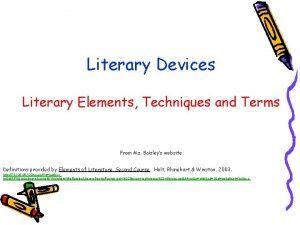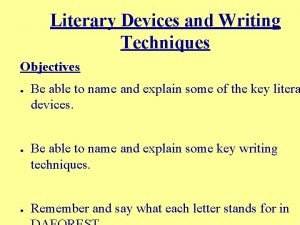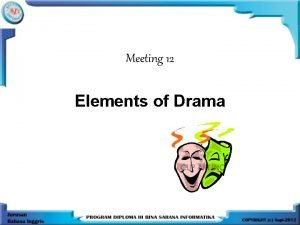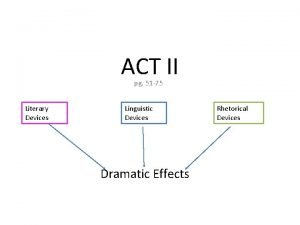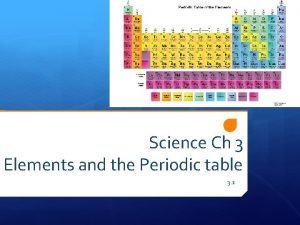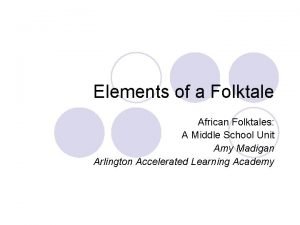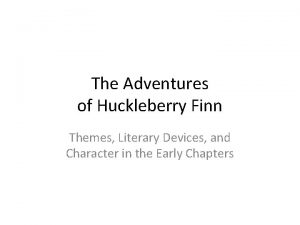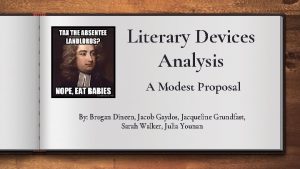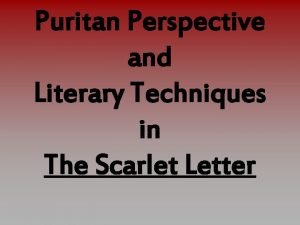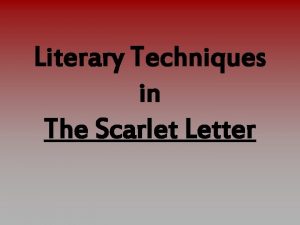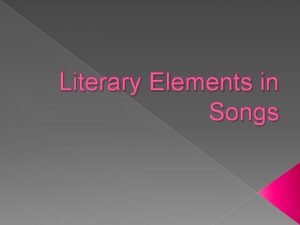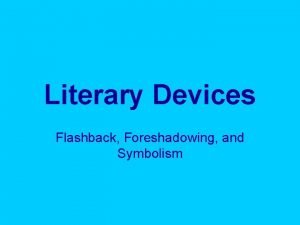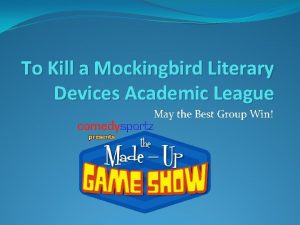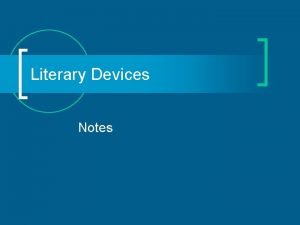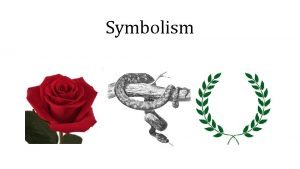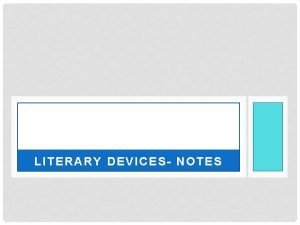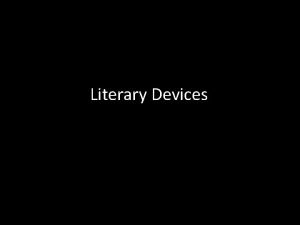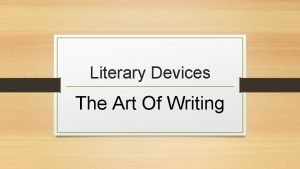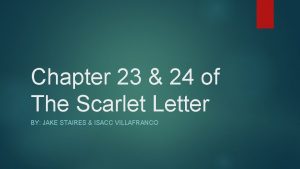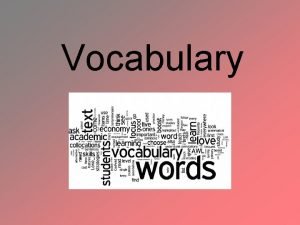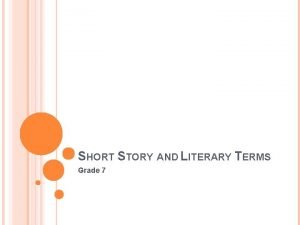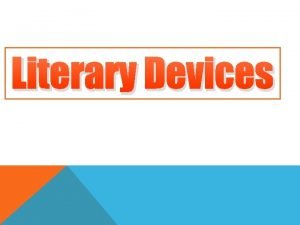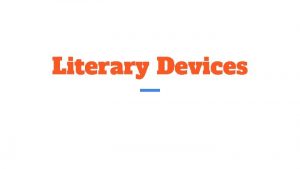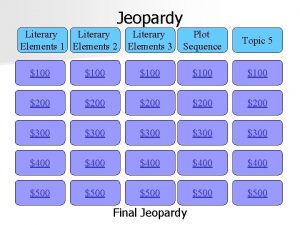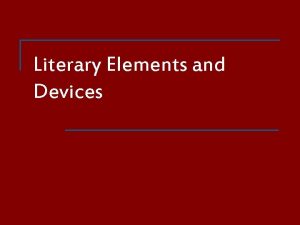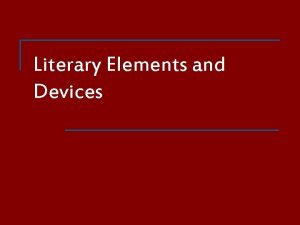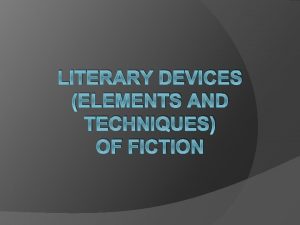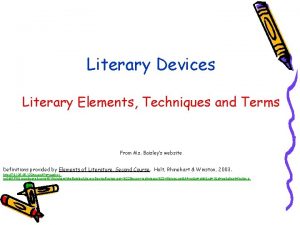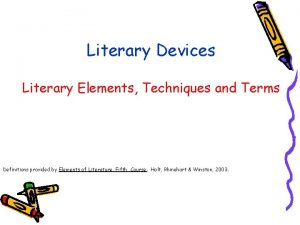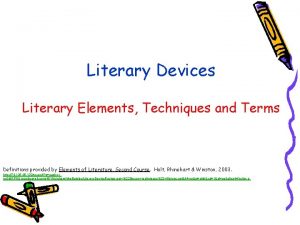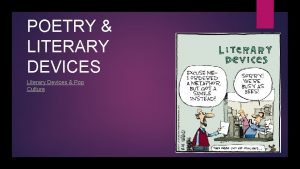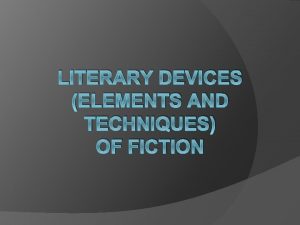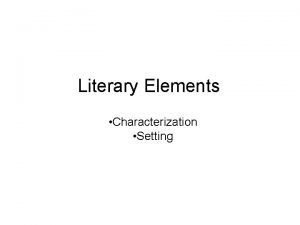LITERARY DEVICES LITERARY ELEMENTS LITERARY TECHNIQUES LITERARY DEVICES

































- Slides: 33

LITERARY DEVICES LITERARY ELEMENTS & LITERARY TECHNIQUES

LITERARY DEVICES • There are two types of literary devices: literary elements and literary techniques. • Literary elements are found in every well-written piece and are essential to the creation of the literary work. • Literary techniques are the “fancy things” authors use to strengthen their stories. They are not essential, but an authorial choice by the writer. • All devices can be used in all genres, fiction, non-fiction, poetry, and drama.

QUIZ TIME! Let’s test your memory: • Write down three (3) literary elements and their definitions. • Provide examples of each literary element. • Share your definitions and examples with your partner. • Be prepared to share your definitions and examples with the class.

WHY USE LITERARY DEVICES? • Literary devices are “tools” used by author’s just as paints and brushes are tools used by painters. • Writers use literary devices to enhance their literary works and make their writing more interesting to the reader.

LITERARY ELEMENTS • Literary elements are in every well-written story. Let’s review some literary elements on the next slides:

SETTING, PLOT, CONFLICT, & THEME • The setting is the time and place in which the literary work takes place. • The plot is the sequence of events in a literary work. • The conflict is essential to any good story. It’s a struggle between opposing forces (good vs. evil) and through the conflict the author will develop theme whereby the main character or protagonist will ultimately learn, or not learn, an important lesson. This struggle can be between two characters, between a main character and society, or between two desires or impulses inside one character’s mind. • The theme is the central idea or message of the literary work, often a perception about life or human nature.

PLOT… tio ac ng isi on acti 3 r lling 5 fa n the organized pattern or sequence of events that make up a story. Every plot is made up of a series of incidents that are related to one another. 4 climax or turning point 2 conflict 1 exposition 6 resolution

CHARACTERIZATION / S. T. E. A. L. The 5 elements of characterization can be explained with the acronym S. T. E. A. L. • SPEAK = what (dialogue) and how (speaker tags & tone) a character speaks to other characters. • THOUGHTS = What a character thinks, believes, values, and what motivates a character. • EFFECTS on OTHERS = The relationships the character has with others and how characters treat each other. • ACTIONS = How a character behaves, including how they react to people and events. • LOOKS = A character’s physical appearance. This includes physical features, clothing, body language, etc.

SYMBOLISM • Some. THING that represents an idea • Can be universal or specific to a story • Universal symbols: colors, seasons, light, animals, etc. https: //www. youtube. com/watch? v=NG 2 zye. VRcbs

FORESHADOWING An author’s use of hints or clues to suggest events that will occur.

FORESHADOWING CONTINUED Little Red Riding Hood: • Once upon a time, there was a little girl who lived with her mother. Her mother asked her to take her old and lonely grandmother some food one day. "Don't stop along the way. Go straight to your Grandma's house and back. Don't talk to any strangers and watch out for the wolf in the woods! Now get along !” What does this excerpt foreshadow? Where do readers specifically see this in the text?

FLASHBACK • An interruption in the narrative to show an episode that happened before that particular point. What purpose does flashback serve for readers?

TONE AND MOOD

ALLUSION A reference to a person, place, idea, or event of historical, cultural, literary, or political significance. • What is being alluded to if a place is described as an Eden? • What is the allusion of the phrase “We’re not in Kansas anymore. ”? In the most high and palmy state of Rome, A little ere the mightiest Julius fell, The graves stood tenantless and the sheeted dead Did squeak and gibber in the Roman streets As stars with trains of fire and dews of blood… And even the like precurse of feared events, As harbingers preceding still the fates And prologue to the omen coming on… (Hamlet Act I, sc i)

IRONY • Verbal: when words are used to suggest the opposite of their usual meaning • Situational: when an event occurs that is exactly opposite of expectation (O’Henry’s “The Gift of the Magi”) • Dramatic: when audience knows something of present or future circumstances that the character(s) do(es) not (Shakespeare’s Romeo and Juliet)

IRONY Additional examples of verbal irony: Verbal irony occurs when words are used to suggest the opposite of their usual and intended meaning: 1. Thanks for the ticket officer! You really made my day. 2. I cannot wait to read this seven-hundred page report! The above examples show irony is used to show someone’s frustration or disappointment.

IDIOM • a saying, phrase, or mixed expression in a culture that has a figurative meaning different from its literal meaning. An idiom gains that meaning through repetition in a culture and is often introduced via literature, media, famous people Examples: 1. It’s all Greek to me. = I don’t understand it; it’s as if it were written in the incomprehensible language of Greek. 2. Break a leg! = Good luck, as said to performers (it’s considered a jinx to directly wish a perform “Good luck!”) 3. Don’t put all your eggs in one basket. = Don’t put all your hope in one thing, as it may not work out.

CLICHÉ • an overused or predictable expression Examples: 1. As red as a rose 2. You can’t judge a book by its cover. 3. Actions speak louder than words. 4. Love is blind.

R. I. D. S. H. A. M. P. O. O. • Use the above mnemonic to remember important and often implemented literary techniques.

REPETITION • The chorus of a song is repeated to draw attention to the important ideas that are being discussed. Likewise, in poetry, literature and nonfiction, writers sometimes use repetition to draw attention to certain details. https: //www. poets. org/poetsorg/poem/still-i-rise ØWhy does Maya Angelou continue to use the phrase “I Rise” in her poem?

IMAGERY • Language that appeals to any of the 5 senses: sight, smell, sound, touch, taste 1. A description of a concert and its sound can be rich in imagery, even if nothing is mentioned about what it “looks like” 2. Likewise, a description of the aromas of your greatgrandmother’s cooking wafting through your house on a summer’s evening consists of imagery- “the warming of cooked onions and oil peppered with the bite of garlic and pungent fish…the familiar char of skin, all creating the rich smell of home”

DICTION • An author’s choice of words—does he or she use elevated language to make it seem more formal? Does he or she use slang? Are there words that are not in English? For what purpose? http: //www. poemhunter. com/poem/mother-to-son/ ØWhat does the diction tell us about the speaker of the poem?

SIMILE • Similes, metaphors and personification are examples of figurative language in which an author attempts to find similarities between dissimilar things • Similes are easy to spot because in the comparison the author uses the words “like” or “as” Example: The school year went by like crystallized honey flowing from a jar-slowly, intermittently, inevitably…

HYPERBOLE • An exaggeration for effect– can show strong feelings toward something Examples: 1. I have a ton of pencils you can borrow. (a ton is 2, 000 lbs!) 2. We waited forever to buy the tickets. 3. I haven’t eaten since breakfast… I’m starving!

ALLITERATION the repetition of initial sounds in neighboring words. Examples: 1. Soothingly, silently, somberly, Anna tended to the wounded child and put her to bed. 2. We went wildly into the woods without looking back.

METAPHOR • Another example of figurative language in which two unlike things are compared– this time without the use of like or as. • Metaphor states one thing IS another; emphasizes more strongly. Example:

PERSONIFICATION • Figurative language in which something nonhuman is given human attributes Examples: 1. The candle’s flame danced throughout the evening. 2. The sky heaved and sobbed a terrible, torrential rain.

OXYMORON • a figure of speech in which apparently contradictory terms appear in conjunction Examples: 1. Bittersweet chocolate (bitter and sweet are opposites) 2. At her funeral, the parlor was filled with a deafening silence (something that is deafening is terribly LOUD, silence is the opposite) 3. Red Lobster is know for its lobster, cheddar biscuits and jumbo shrimp. (jumbo means huge, shrimp means tiny)

ONOMATOPOEIA • Words that sound like their meaning Examples: Sizzle, splatter, crash, boom, hush, splash, hiss

REVIEW GAME/EXIT SLIP • After each clue, jot down answer on exit slip. Do the best you can. • Good luck!

QUESTION 1 • Video Clue https: //www. youtube. com/watch? v=h 8 n. Hl-2 VRvg

QUESTION 2 • "The gray-eyed morn smiles on the frowning night, /Check'ring the eastern clouds with streaks of light. " (Friar Laurence from Romeo and Juliet)

QUESTION 3 • Phone service out of order? Give us a call.
 What is poetic devices
What is poetic devices Imaginative comparison examples
Imaginative comparison examples Elements and techniques
Elements and techniques Literary elements and techniques
Literary elements and techniques Techniques and literary devices in drama
Techniques and literary devices in drama 75 literary terms elements and devices
75 literary terms elements and devices Fonctions techniques et solutions techniques
Fonctions techniques et solutions techniques Elements of drama literature
Elements of drama literature Elements and sub elements
Elements and sub elements Molecular element
Molecular element Http //elements.wlonk.com/elements table.htm
Http //elements.wlonk.com/elements table.htm What are the three elements of a folktale?
What are the three elements of a folktale? Where is the setting of the folktale
Where is the setting of the folktale The adventures of huckleberry finn literary devices
The adventures of huckleberry finn literary devices The lottery analysis shirley jackson
The lottery analysis shirley jackson A modest proposal figurative language
A modest proposal figurative language Gothic sentence examples
Gothic sentence examples Literary techniques in the scarlet letter
Literary techniques in the scarlet letter Personification in the scarlet letter
Personification in the scarlet letter Simile in songs
Simile in songs Literary device flashback
Literary device flashback To kill a mockingbird literary devices
To kill a mockingbird literary devices Literary devices allusion
Literary devices allusion Literary devices comparison
Literary devices comparison Symbolism literary device example
Symbolism literary device example Poetic devices allusion
Poetic devices allusion Allegory literary devices
Allegory literary devices Literary techniques in romeo and juliet
Literary techniques in romeo and juliet Chapter 23 scarlett letter
Chapter 23 scarlett letter Input and output device
Input and output device Literary terms jeopardy
Literary terms jeopardy Literary elements character
Literary elements character Literary devices in taming of the shrew act 3
Literary devices in taming of the shrew act 3 Short story setting
Short story setting

